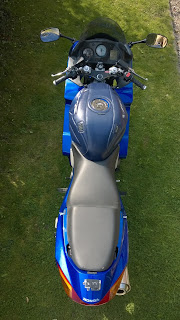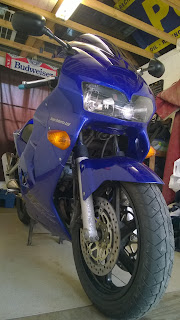The Stud that told me about it.
If you have previously read about my pipe fitting fun then you will know I managed to snap a stud in the process.
With the increased decibels of a full stainless system with carbon can I had not noticed much noise but as time wore on and a bit of exuberant riding later a noticeable splutter on the over run was starting to become creep in.
Extraction
Stud extraction is a pain.
VFR800 studs are something else. At only 6mm they snap easy and are a bugger to remove.
Luckily for me the stud had gone just under the nut so I had something to grip onto.
I had been soaking the stud in anti-seize compound for a while so I was fairly well prepared for this. Clothes off (the bike not me), pipes displaced and sat in the garage I was ready to tackle this.
With no threads or welding equipment another nut was out of the question so I went for a stud extractor I had spotted in a mates tool kit. I had planned to use easy outs so this was a bonus.
Stud Extractor
After a faltering start by finding out the studs were 6 not 8mm, I got the correct stud extractor to hand. I had ran the bike up to get some heat in the lump before so making heating the stud further with a blow torch to help break it free a bit quicker. Then I located the extractor on the stud and began to turn.
Then I rapidly stopped.
Unfortunately as is often the case with these things I had no space to work and the T handle on the extractor was impacting part of the engine before the rollers engaged the stud.
A problem but not the end of the world. I completely removed the front exhaust link piles and displaced the back so it hung down out of the way. Using a small screw driver I was able to rotate the rollers on the extractor so they were starting to engage as I slipped the extractor on for another go.
An n'th of a turn and they bit in.
Success!!
The handle stiffly continued to turn. I continued for a while with a similar resistance felt so stopped.
I removed the extractor to see what I had achieved and if, just maybe, I could finish turning the stud out with pliers. Unfortunately I found the stud hadn't budged.
Bugger!!
All I had achieved was to dig some score marks into the surface of the stud. The extractor just wasn't going to do it sadly.
All I had achieved was to dig some score marks into the surface of the stud. The extractor just wasn't going to do it sadly.
Easy outs
I had hoped I wouldn't need to use these but here I was with a box of easy outs and a drill.The smallest easy out I has, needed a 4mm wide hole, leaving little error with drilling.
My drill bits were looking worse for wear as they tickled the now hard as nails stud.
Tough when you want to be eh?
Fortunately a wise acquisition and my memory worked in tandem as I remembered I had some Cobalt drill bits in a box. These did allot better and quickly formed a sufficiently deep hole in the stud.
I tapped the extractor into place and dug out a tap for it. Straight away though it was obvious it would not fit in the space to actually turn it.
Not ideal.
The only option I had now was to grip the end of the easy out with mole grips and turn it that way. This is not easy as they don't fit square and the slightest off centre turn would cause the easy out to step out of the hole.
This happened a number of times before I got a decent go only for it to go loose again. I looked at the hole which was not conically enlarged so I drilled deeper and tried again. and again.
Sadly all I achieved was splaying out the end of the stud. Cutting this back and starting again from flush with the head made things not easier either.
I asked about a bit with friends and someone lent me a smaller easy out. This slipped nicely into the pilot hole and gripped tightly.
Success!!!
Now with my Mole grip turning technique down to a T, I turned the extractor. It bit deeper and deeper into the stud before finally cracking off, the top of the extractor.
Balls!!!!
No Mersey
Now suitably pissed off with everything in the garage I picked out the now broken extractor and stuck it in the bin taking little solace in how easy it came out.
Returning to what was left of my friends tools I was surprised he lent me his Helicoil kit as I was clearly incapable of basic hand skills.
Chucking on a 6mm drill I removed what was left of the stud then used the special drill bit that came with the Helicoil kit to drill the head out to the correct size.
With this done I was able to tap the hole with my amazing Mole grip turning technique and fit the Heliciol insert without any dramas.
Phew.
Rebuild
Slotting everything back together shouldn't have been too much of a bother but sadly I had to loosen the rear headers before I could reconnect them back to the collector box to make everything align at the front.
By now every step needed a cup of tea and a pause to prevent me loosing my temper with the damn thing.
Finally with everything on I was able to slot some copper slip coated gaskets under the headers and gingerly wind the torque down on the head bolts.
As you can see everything held well save for one slightly wonky stud which is going to get a damn good ignoring.
Having done all this the bike ran up fine popping and farting just as much as it was before.
Git.
As there is no air escaping around the flanges I'm going to put this down to fueling and the PASS system which apparently causes this problem with bikes that have after market exhausts.
Speaking of which I remembered I had not photographed the full exhaust system fitted.
I still haven't but here is the front bit anyway.


.jpg)


Comments
Post a Comment